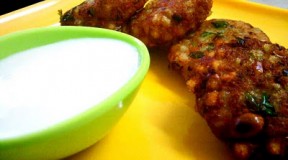As a child, I often wondered which tree bears the sabudana fruit. Maybe it’s a crop. But we never studied it, although we ate it so voraciously. I learnt where sabudana comes from only a few years back.
Sabudana is made from Tapioca. Or sago. In India, its commercially produced as pearls of different sizes. Often, it is used to make the famous sabudana khichdi, primarily eaten in Maharashtra and parts of Gujarat but has spread to most parts of the country as a popular breakfast menu option. It is eaten in kheers with vermicelli and/or rice cooked in milk, sweetened and seasoned with spices like green cardamom and dry fruits like sunflower seeds, raisins and cashews, almonds.
It is also used as a thickener. Sort of similar to how cornflour is used in soups for thickening.
Then there is the sabudana wada. It’s served in different ways in different families but most commonly, its a big round patty that is deep fried and served with slightly sweetened, whipped yogurt.
The sabudana wada is a hearty snack, fills you up and best eaten at breakfast or early in the evening. NEVER have this for dinner. It takes a while to digest and the last thing you want to do after eating this is to lie down.
Make this. It makes people very happy. Half my regrets about not cooking enough melt away when I make this.
PS: Some people prefer their sabudana wadas served with tomato ketchup. Suit yourself. And some people also like their sabudana wada cooked till a light brown. I do not. I prefer them deep golden brown so I know it is cooked through and the outside is crunchy and crisp but the inside is all hot and melt-in-the-mouth.
Recipe: Sabudana Wadas
Prep Time: 10 minutes to boil potatoes, 6 hours of soaking time for Sabudana, 10 minutes to assemble, 5 minutes to cook
Cooking Time: 5 minutes
Recipe Source: Standard family recipe.
Serves: 2-3 people, makes 10 wadas
You need:
3 big potatoes, boiled
6-7 tbsp sabudana, soaked overnight
2 tbsp roasted jeera / cumin seeds
3-4 tbsp, roasted peanuts, skin removed, roughly ground (chunks are mandatory)
2 green chillies, chopped fine
Lots of coriander leaves, chopped fine
Salt
Oil for deep frying
(Note: If your sabudanais half-a-cup, the water should reach up to 2 cms above the level of the sabudana – so basically, no drowning the pearls in too much water but too little will not work either. When ready, test a pearl by biting into it – if you can comfortably bite into it, no hardness, it is ready.)
Here’s what you do:
– Mash the boiled potatoes till no lumps remain. No need to mash the hell out of them, like you would for creamy mashed potatoes. Just make sure all lumps are gone.
– Add the sabudana, salt to taste, green chillies, coriander leaves,jeera seeds.
– Add the roughly ground roasted peanuts. Make sure the skin is gone. One way to do this is to cool the peanuts down and then give them a nice run between your palms – the skin just comes off. blow on them to make the skin fly away. Please do this in the sink, you don’t want peanut skin all over your house.
– Make sure the peanuts remain chunky after they are ground. We do not want a fine powder. Which is why I avoid the grinder and just use my mortar pestle and crack open all peanuts.
– Mix everything thoroughly with your hand.
– Now make flat (but not too flat, neither too thick in the middle) patties. Keep them aside for 5 minutes while you get the oil hot.
– When the oil reaches smoking point, lower the flame, carefully lower 1-2 wadas into the hot oil with a perforated ladle. DO NOT try to lower the wadas into the hot oil with your bare hands. Sabudana crackles pretty violently in hot oil and tends to spill oil out.
– When golden deep brown on both sides, remove on to a tissue to soak the extra oil. Serve immediately with whipped, sweetened yogurt. Or tomato ketchup if you like that better.
Reema Prasanna is a personal and corporate baking coach from Mumbai, blogs about her experiments in the kitchen, records recipes from India, and in another parallel dimension, she is also a Search Engine Marketing Professional, fiction writer and maniacal utensil & kitchen tool collector.






